Landscaping with succulents and cacti – 8 stunning ideas to transform an arid yard
Expert advice and inspiration to help you discover how to integrate succulents and cacti into your outdoor space


If you live in an arid climate and are wondering how to introduce landscaping with succulents and cacti ideas into your yard as a more appropriate form of planting, the good news is this is one of the most low-maintenance designs you can choose - and it looks super stylish.
Creating a garden mainly planted with succulents and cacti also ticks the sustainable landscaping box, especially if you choose native plants that are drought tolerant, and source local landscaping materials to accessorize the design. By choosing plants that naturally occur together in hot, dry regions you can also be confident they will look right together and will flourish in your climate.
We have gathered inspiration for your backyard landscaping ideas with advice and guidance on how to work succulents and cacti into your garden design.

Beautifully textured planting is set off perfectly by a top dressing of chunky crushed stones
8 ways to landscape with succulents and cacti
Succulents and cacti can be used in a variety of beautiful ways to transform your landscape. These versatile plants can be used in more contemporary symmetrical designs or left to grow informally as part of your garden design.
'There are countless different shapes and sizes to play with when choosing succulents, from tall, columnar cacti to those that are only a few inches in height,' says horticulturalist Noelle Johnson, author of Dry Climate Gardening, available from Amazon. 'Columnar cacti can be placed in similar locations as trees to serve as a central focal point or interspersed throughout the garden to create multiple vertical visual statements.'
Medium-sized succulents such as agave make an excellent filler for bare areas as part of your desert landscaping ideas, while the prickly pear cacti with their distinctive paddle-shaped stems add a welcome twist on texture in the garden, adds Noelle. Meanwhile low-growing succulents like golden barrel cacti can be planted in groups and used as groundcovers.
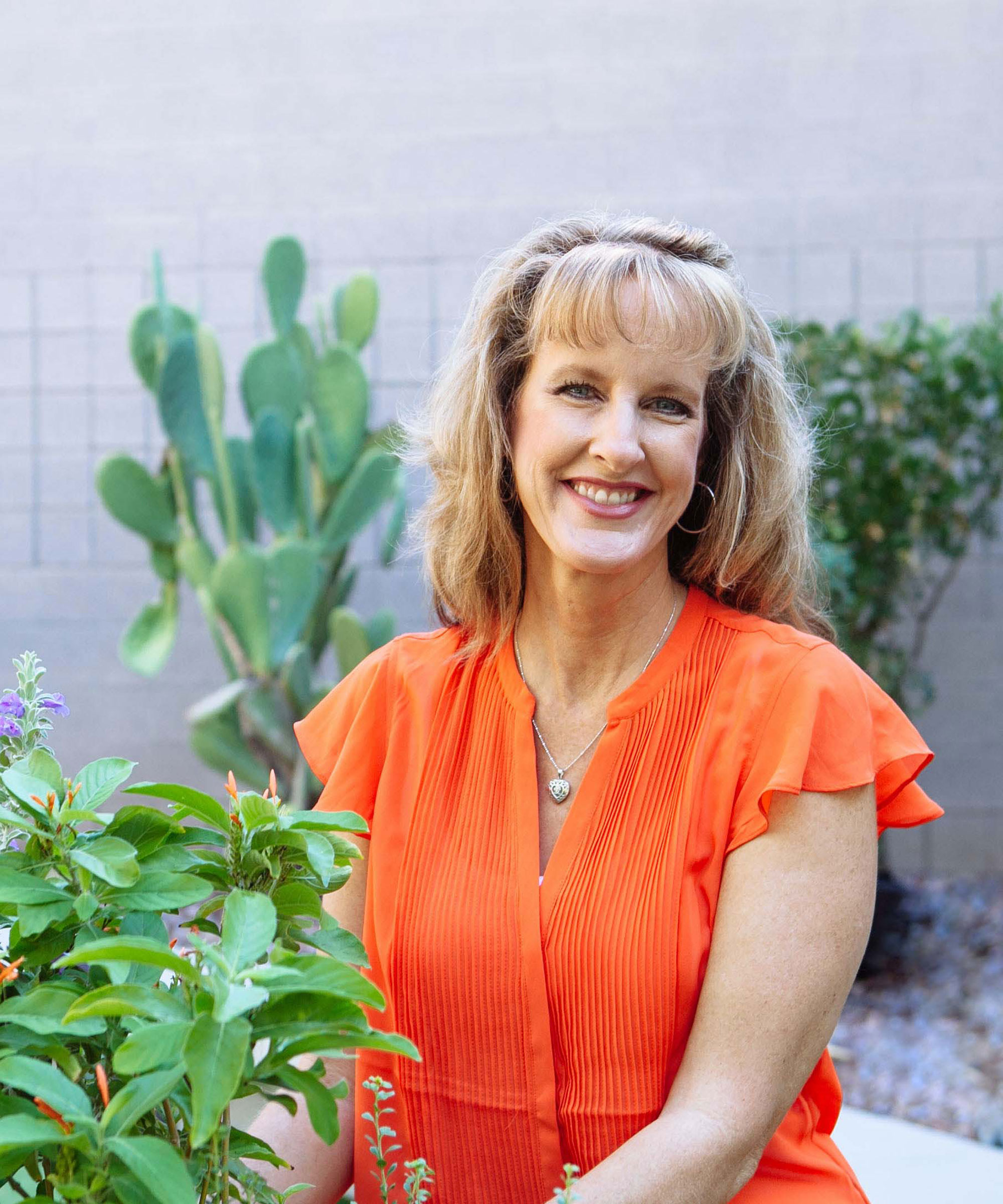
Noelle is a horticulturist, landscape consultant, and garden writer who lives in the Phoenix, Arizona, metro area. Popularly known as the 'AZ Plant Lady,' her passion for over 20 years has been to inspire and teach people to create, grow, and maintain beautiful gardens that thrive in a hot, dry climate.
1. Use scale and proportion in your design

Large agave plants lend a sculptural element to any landscape but you can also display small agaves in a container and they will look equally good
When thinking of succulents and cacti you probably envisage small plants on a windowsill. But take the best type of succulents outdoors and these beauties will transform your landscaping.
Design expertise in your inbox – from inspiring decorating ideas and beautiful celebrity homes to practical gardening advice and shopping round-ups.
Add a majestic variety of agave or yucca to your garden planting and it can be more beautifully sculptural than, say, a large evergreen shrub or small ornamental tree. Meanwhile smaller types like echeveria and sedum can add lovely textured detail to rock gardens and living wall displays.
'Scale and proportion have to do with the size of plants and structures in the landscape as they relate to one another and to the whole,' says horticulturalist and succulents expert Debra Lee Baldwin, author of Designing with Succulents, available here from Amazon. 'A landscape with properly proportioned elements feels inviting. Correct scale and proportion can be as simple as placing small plants in small spaces and big plants in large spaces.'

Debra Lee Baldwin specializes in showing how landscape and garden designers use dynamic, sculptural succulents in a wide variety of eye-catching applications. Her own garden is in the foothills northeast of San Diego. In 2017, Debra was honored as "Horticulturist of the Year" by the San Diego Horticultural Society. She is an in-demand speaker on the horticultural circuit and her YouTube channel has more than 8,000,000 views.
2. Choose native varieties of cacti and succulents
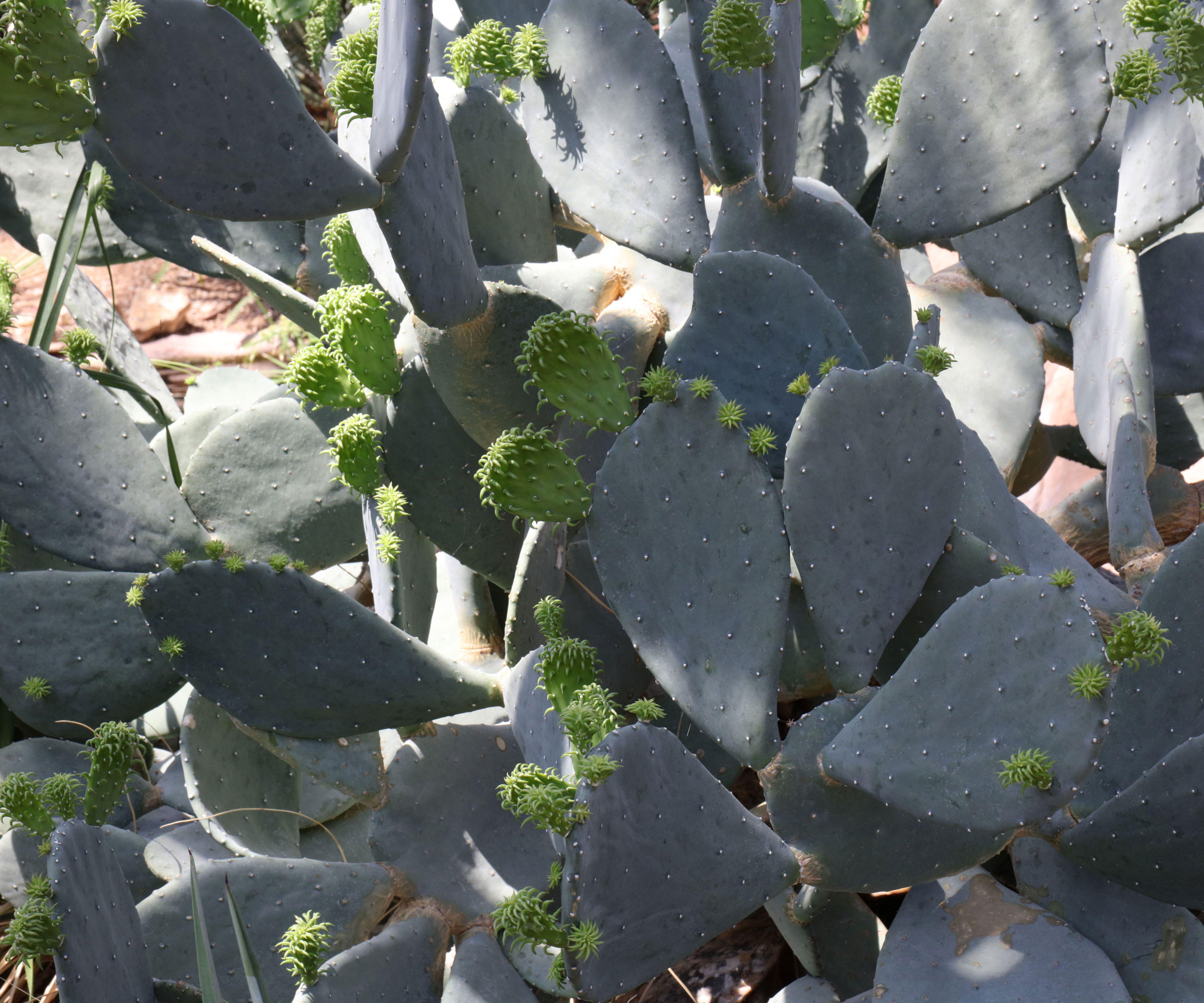
The sprawling prickly pear cactus is an asset in any yard
Make restoring native plant habitats a key part of any new landscaping project. This means choosing plants that occur naturally in a region in which they evolved. By creating a native plant garden to preserve biodiversity your yard becomes part of a collective effort to sustain the landscape for wildlife.
A favorite native plant for landscaping is the prickly pear, which is one of the best desert plants. 'Our coast prickly pear is native to Southern California and Baja California, where it grows in coastal sage scrub and our maritime chaparral,' says Dr Ari Novy, president and CEO of the San Diego Botanic Garden. 'The plant plays a key role in local wildlife support.'
These plants have adapted to the dry, hot climate by storing water in their stems. 'Sometimes called the sprawling prickly pear, this cactus has short stems and a habit of growing close to the ground,' says Ari. 'The leafless stems store water to carry it through drought. The red-tinged yellow flowers bloom April through June, but the plant is beautiful all year round.'
Definitely one to include in your drought-tolerant planting ideas.
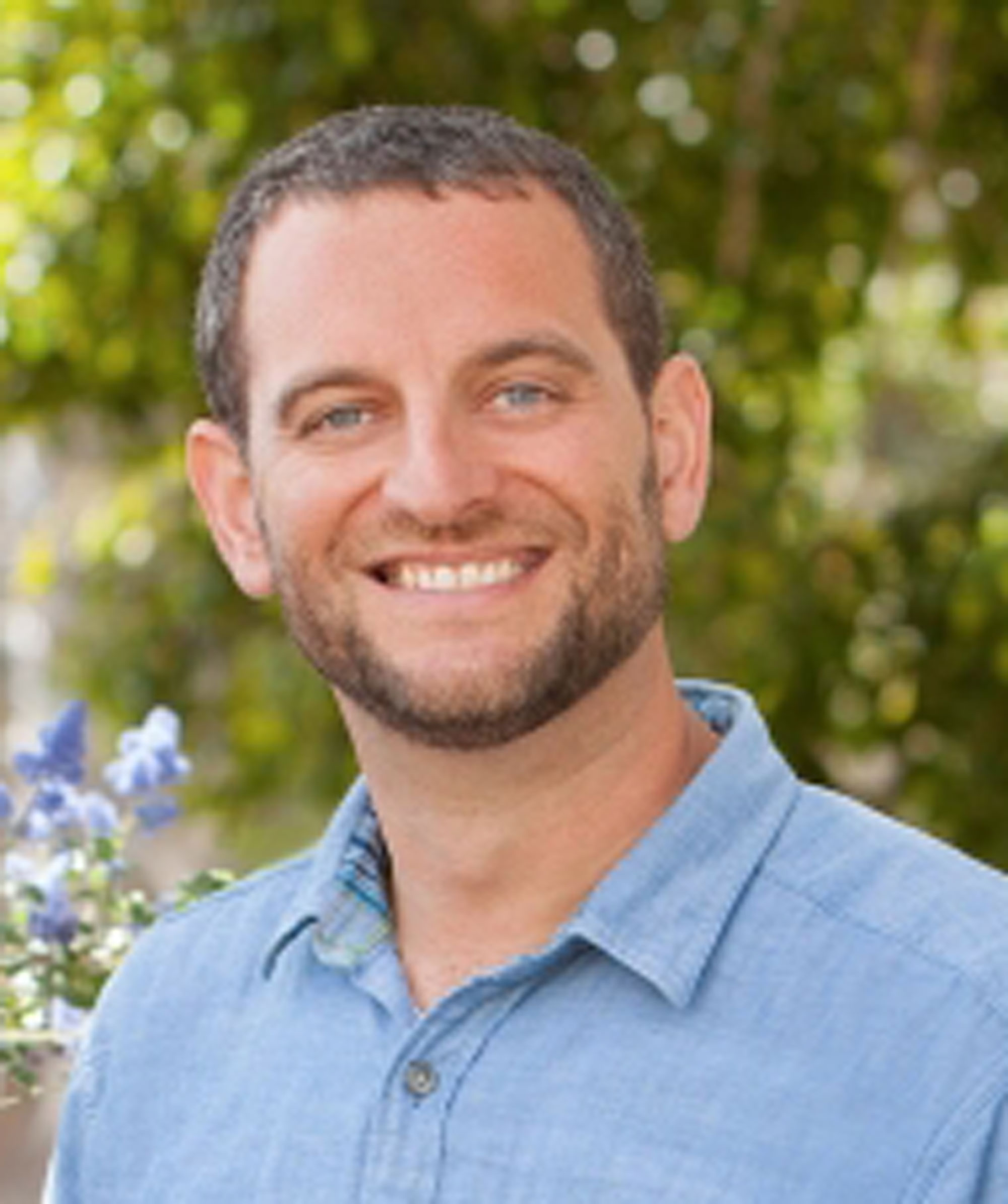
Dr Ari Novy is president and chief executive officer of the San Diego Botanic Garden. He is a plant biologist with a wide range of expertise in plant science and education. In addition to his role at the garden, Dr Novy is an active researcher, holding an appointment as Adjunct Associate Professor at Salk Institute for Biological Studies. He is the author of numerous peer-reviewed scientific papers and regularly speaks on various horticultural and botanical topics nationally and internationally.
3. Repeat plant two or three varieties
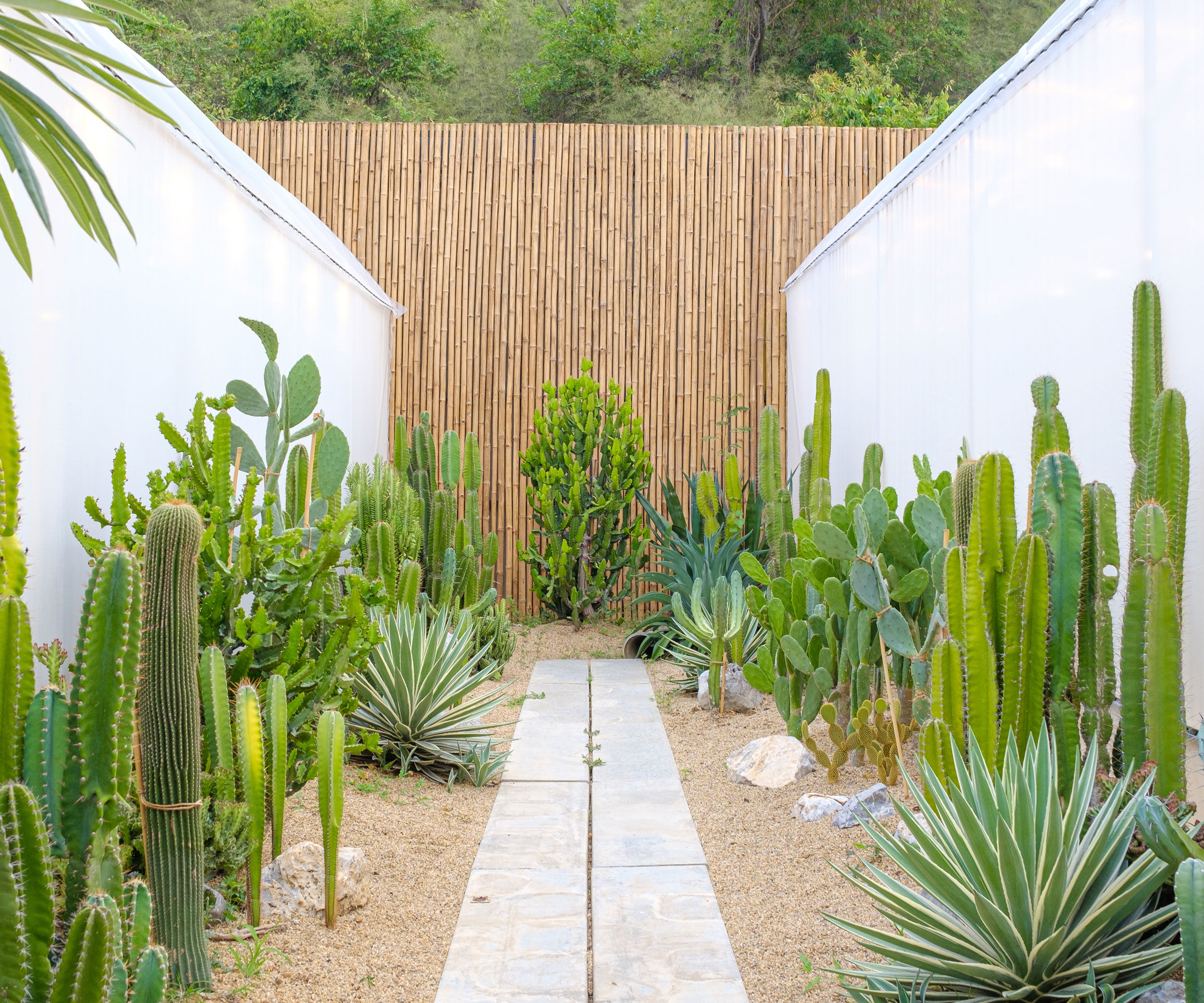
A few different types of cacti and succulent are used in this contemporary scheme to create a repetitive pattern that enhances the space
A key principle of landscaping design is repeating plants of the same flower or foliage color and texture. This repetition draws the eye smoothly through the garden. The same is true when you are landscaping with succulents and cacti.
'Perhaps more than any other plants, succulents – because their leaf shapes are distinctly pointed, oval, or cylindrical – offer opportunities for crisply defined repetitions of form,' says Debra Lee Baldwin. 'Repetition is essential for unifying a landscape. Large agaves, in particular, illustrate this: just three of them, all the same and strategically placed, will lend continuity to a garden regardless of its other components.'
Repetition is not always multiples of the same plant, Debra points out. There are subtler ways to achieve it, such as with patterns, textures, and silhouettes. For example, a yucca planted near an agave shares the same spiky shape so adds the feeling of carrying on the design.
4. Introduce color to enhance your planting design

The gorgeous blooms of torch cactus add a pretty color pop to your landscaping ideas
Plants with colorful leaves and flowers add standout to your dry garden landscaping with succulents and cacti. Succulents have foliage in a wide range of colors (like blue finger succulent) and pretty flowers, while some varieties of cacti have stunning blooms too.
'Grown en masse, succulents with colorful foliage make an unforgettable display,' says Debra Lee Baldwin. 'Solo, they serve as the centerpiece of a potted arrangement or as garden focal points. And when a colorful succulent is juxtaposed with other boldly-hued plants or objects, the contrast is as dramatic as it is delightful.'
Horticulturalist Jac Semmler, author of Super Bloom, available at Amazon, is a big fan of using sedum in dry gardens. 'Their leaves vary in shades of blue, green, gray, purple and even gold,' she says. 'Depending on the cultivar, stems of various lengths stretch up to form a domed cluster of flowers. Sedums are a wondrous combination of resilience and beauty, with flowers that attract pollinators.'
For landscaping purposes sedums can be divided into evergreen ground cover varieties and taller stemmed herbaceous perennials with large flowers.
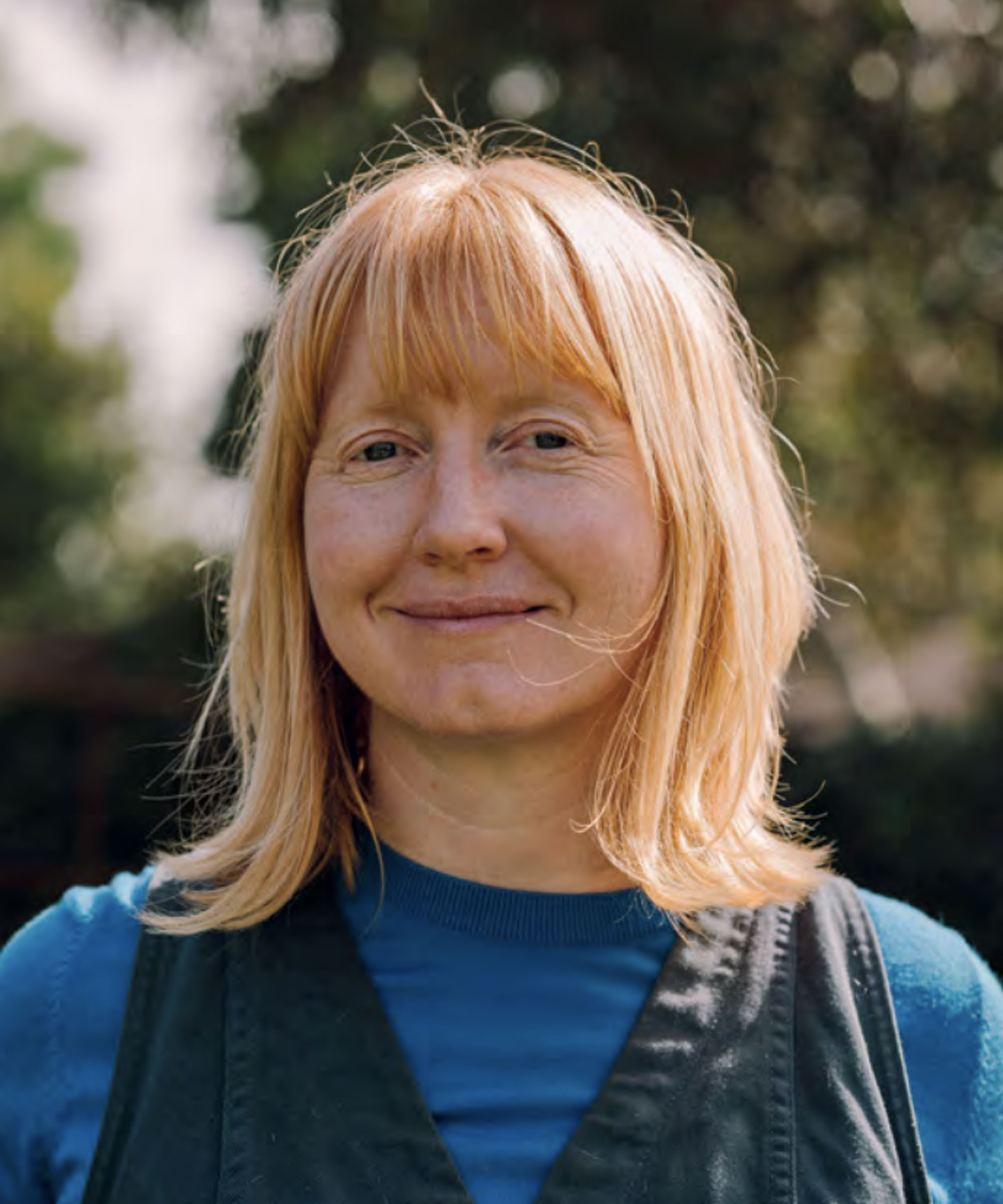
Jac Semmler is foremost an experimental gardener and plant lover. She tends to Super Bloom, a creative plant practice that brings dynamic living beauty and diversity to urban spaces, landscapes and creative projects. Jac is a qualified educator, respected horticulturalist and botanical guide, and often shares her ideas at festivals as well as on radio and podcasts.
5. Mix in boulders and rocks with your planting

The best ideas for landscaping with succulents and cacti usually include a mix of vertical and horizontal planting
Interspersing planting with boulders, crushed stones, and pebbles will add interest to your landscaping with succulents and cacti. It means your design will shift away from looking flat and desert-like towards a more interesting terrain.
'Boulders are a popular element for dry climate garden design,' says Noelle Johnson. 'They serve as a great visual anchor for plants. Pair a boulder next to a plant, and it looks better due to the mixture of heights and differences in texture. It's a great way to add height in a relatively flat landscape.'
When choosing boulders and rocks for your garden, the size of each one should be in scale with the size of your space, says Noelle. For example, if you have a smaller garden, select a boulder that is perhaps two feet in width and 16 inches tall. Larger landscapes will need larger rocks. 'To create a more natural appearance, once you have your boulder in the desired position, bury the bottom one-third,' she suggests.
Source locally when choosing landscaping ideas with rocks as these will blend in with the terrain. Whether you are shovelling pea gravel or craning in a huge statement boulder it will be worth the effort when you see what it brings to your landscaping.
6. Create bold and dramatic silhouettes

Play with different heights to create an interesting cacti display against a wall or fence
A simple white wall or plain fence can be transformed into a strong design feature with a display of tall, columnar cacti or shapely succulents such as aloe vera or Aeonium arboreum.
'One design element often overlooked in the garden is the shadows that plants can reflect, adding another layer of interest,' says Noelle Johnson. 'Not surprisingly, the curved and spiky shapes of succulents and cacti create nice shadows on vertical surfaces when the sun shines on them. A bare wall can be transformed by placing plants when oriented in an east- or west-facing direction.'
If you want an instant fix grow tall succulents or cacti in large pots as part of your summer container planting ideas to create a statement feature and add more depth to your space.
7. Make gravel your go-to landscaping material
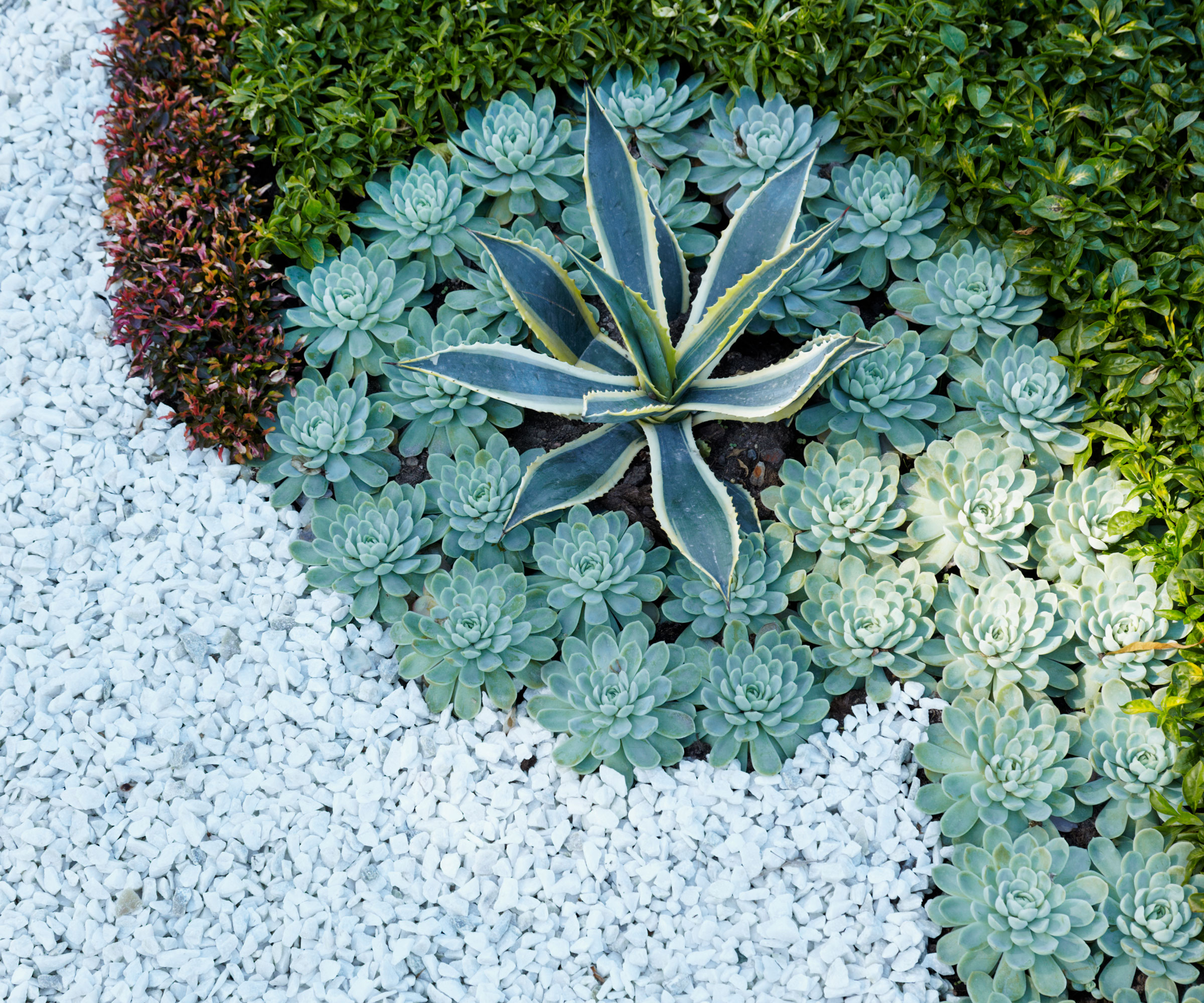
Gravel looks super smart when contained in a geometric design
Gravel is the number one choice of landscaping material if you live in a dry climate and is the super star when it comes to xeriscaping. Cheap to buy, easy to spread and widely available, it’s a practical material that looks good and is versatile too, so make it integral to your landscaping with succulents and cacti.
You can use small pockets of gravel as mini beds for cacti or succulents in modern geometric designs combined with pavers, or top dress flowerbeds with it as part of a much bigger landscaping project. You can also use gravel to make pathways through your planting.
The best type of gravel for landscaping is pea gravel, which tends to be a favorite tool of garden designers as the finish looks so professional. The small smooth and rounded stones come in a choice of natural colors, including cool shades of gray and crisp white, as well as warm golden and tan tones.
8. Plant up an interesting container display
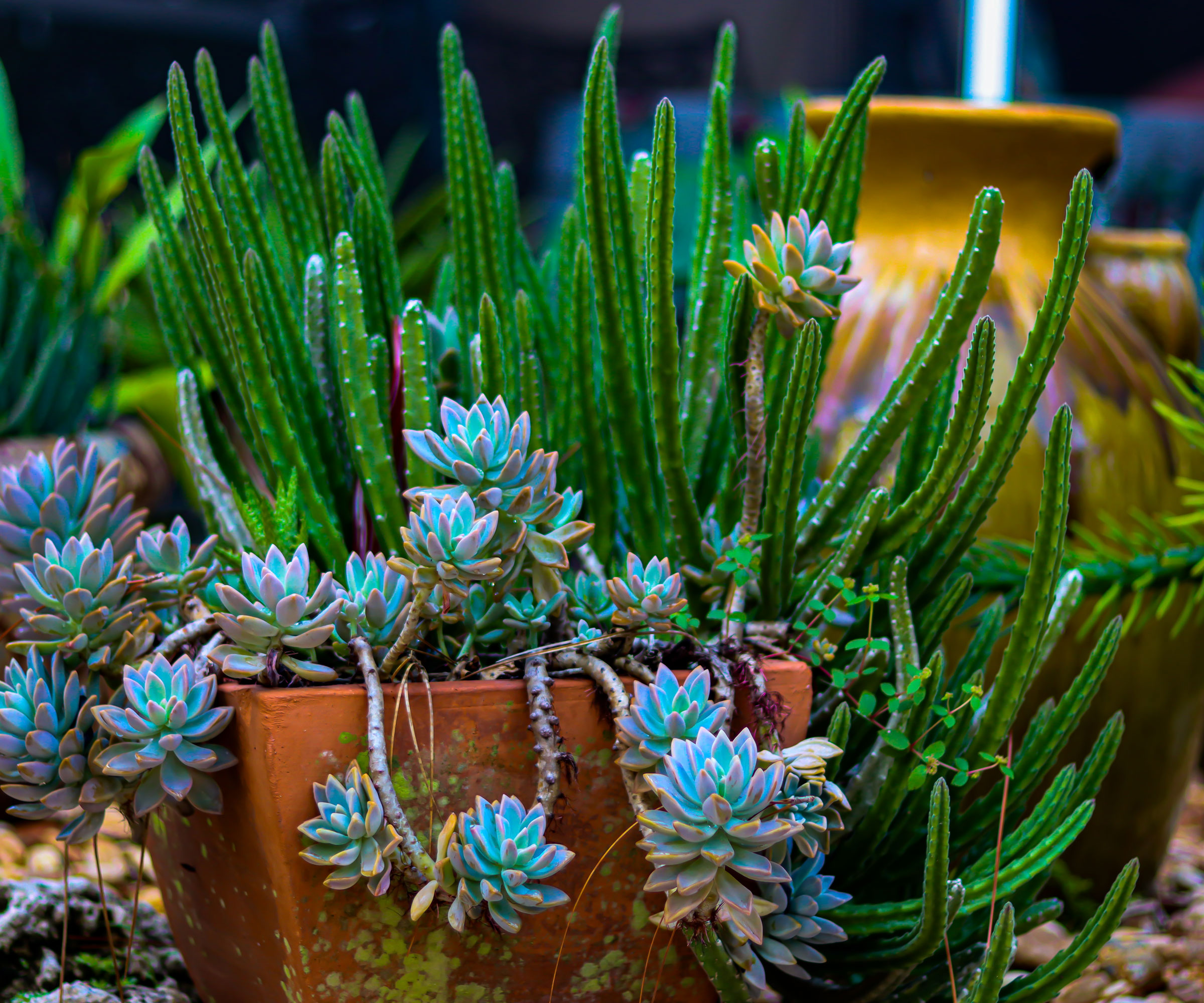
Choose several pots and plant up with succulents and cacti to create a mini-landscape
If you don't have a huge yard you can still tap into the landscaping with succulents and cacti trend by using potted plants on roof garden patios, balconies, and decks. You can also plant them in vertical garden ideas and green roofs, as well as hanging terrariums.
The other good news is that these are low-maintenance container gardening ideas and will thrive for a few years before you need to replenish the soil or shift your plants into a larger pot. If you're planning on quite a few containers co-ordinate one or more design elements by grouping together complementary plants, materials or colors.
'Containers can transform an urban balcony into an inviting, easy-care garden space,' says Debra Lee Baldwin. 'Succulents need little pruning or deadheading, grow slowly when their roots are confined, and come in varieties suited to any container and amount of sun or lack thereof. And where no hose is handy, plants with minimal water needs are ideal, especially when drainage is problematic.'
Succulents lend themselves to vertical gardens, says Debra, because the plants are shallow rooted, stay compact, survive even if the growing medium dries out, and come in colors useful for creating patterns and designs.
FAQs
Can cactus and succulents be planted together?
Yes, cactus and succulents can be planted together as part of your landscaping design. Both like sunny, dry, well-drained conditions and thrive in high temperatures. Even if you want to put them together in a container they will be happy with the arrangement and it will look really effective too. The main consideration when planting cactus and succulents together is to group plants according to their water requirements.
When it comes to watering, cacti tend to need less water than succulents, but larger plant specimens will generally need more hydration than smaller ones. If you love the idea of landscaping with succulents and cacti you can find out more here about drought-tolerant landscaping ideas and how to design a drought-tolerant yard that's sustainable, looks beautiful, and also reduces your water usage.

Lifestyle journalist Sarah Wilson writes about garden design and landscaping trends for Homes & Gardens. She has studied introductory garden and landscape design, and also has an RHS Level 2 qualification in the Principles of Plant Growth and Development. She is a regular contributor to Homes & Gardens and Livingetc. She has also written for Country Living, Country Homes & Interiors, and Modern Gardens magazines